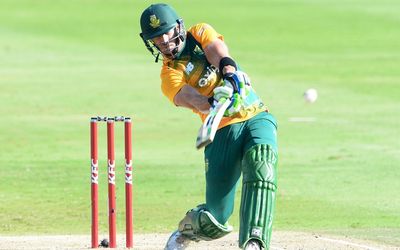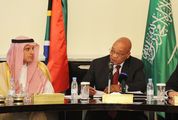FAF du Plessis and head coach Russell Domingo, along with the rest of the coaching and management team, have been planning their bid for the imminent Twenty20 World Cup for the past two years ever since the last one was snuffed out by India at the semifinal stage.
It’s not like they’ve been doing video analysis on the opposition every day and discussing game plans at every opportunity, but it’s always been there, at the back if not the forefront of their minds.
Since the 50-over "real" World Cup also ended with semifinal heartbreak a year ago against New Zealand, it has certainly been a priority.
For some weeks before and even after the last International Cricket Council Twenty20, Domingo patiently defended the strategy of batting AB de Villiers in the middle order.
He is passionate about statistics and he produced many of them to illustrate why the world’s best batsman would serve the team best by being involved at the end rather than the beginning of the innings.
But everybody else disagreed and eventually, Domingo’s patience ran out and he became snappy and ill-tempered, suggesting that perhaps all the former players turned commentators would like to take over his job.
But perhaps he listened after all, because if — as Du Plessis says — they really did start planning two years ago, then maybe the decision to start with De Villiers as an opener was made back then, even as Domingo was justifying the middle order tactics.
De Villiers’ partner at the top of the order, it seems, will be either Hashim Amla or Quinton de Kock.
It appears there is not room for both.
If there were, then De Villiers would be batting at number three, which is, in fact, the best place for him to perform in the shortest format, affording him a few overs respite against the brand-new ball.
But the captain bats at number three and that is a nonnegotiable.
Du Plessis has the ability to be both creative and imaginative, but he can also be ruthless in sticking to a plan.
He speaks often about the importance of every player "understanding their role" and "knowing their job".
Whereas fielding positions and the occasional bowling change can be instinctive, batting positions are carved in stone and provide the foundations upon which the Twenty20 campaign will be built.
Du Plessis’ conservatism may be genetic or the product of his upbringing, but it may also be a reaction against the "superfluidity" that Gary Kirsten attempted to introduce during his tenure as coach of the national team.
Kirsten’s belief was that three, or even four, batsmen should be able to share and rotate positions, keeping them mentally and physically fresh.
Du Plessis was not a fan of that theory and neither, to be fair, were many of the other batsmen.
The concern now, however, is that thinking and planning have become too rigid.
If De Kock and Amla look imperious in the warm-up games in India, will one of them still miss out just because they have both spent their careers opening in limited-overs cricket?
What if neither Rilee Rossouw nor Farhaan Behardien are convincing in India — could De Kock really not do a decent job at five?
The flip side to Du Plessis’ reluctance to be flexible is that it represents strong leadership and a valuable sense of security and confidence to the players.
He is intransigent in what — and whom — he believes.
So, while a senior player such as JP Duminy might be looking over his shoulder and worrying about the whispers during what feels like a prolonged slump, Du Plessis will be reminding him that it was, in fact, just six games ago that he was blasting 64 from 32 balls at 18 runs per over to beat India.
Perhaps the captain’s immovable claim to the number three spot sends a message of resounding strength to the rest of the team, that he will take responsibility for every innings from the most important position in the order.
If this was a different century, he would be riding the largest horse and carrying the flag.
Man for man, Australia will have the best team at the World Cup, but they had lost five games in a row before Sunday’s thriller at the Wanderers after picking their team like Lotto numbers.
Perhaps that’s another reason Du Plessis wants everyone arriving in India knowing what will be asked and expected of them.
But, a captain always needs to leave room for change and some flexibility.
He doesn’t have to stick to the XI or the game plan just because it’s the one he and the coach wrote down two weeks earlier.
Or two years.

Faf du Plessis of the Proteas during the 2nd KFC T20 International match between South Africa and Australia in Johannesburg on Sunday. Picture: GALLO IMAGES/LEE WARREN
FAF du Plessis and head coach Russell Domingo, along with the rest of the coaching and management team, have been planning their bid for the imminent Twenty20 World Cup for the past two years ever since the last one was snuffed out by India at the semifinal stage.
It’s not like they’ve been doing video analysis on the opposition every day and discussing game plans at every opportunity, but it’s always been there, at the back if not the forefront of their minds.
Since the 50-over "real" World Cup also ended with semifinal heartbreak a year ago against New Zealand, it has certainly been a priority.
For some weeks before and even after the last International Cricket Council Twenty20, Domingo patiently defended the strategy of batting AB de Villiers in the middle order.
He is passionate about statistics and he produced many of them to illustrate why the world’s best batsman would serve the team best by being involved at the end rather than the beginning of the innings.
But everybody else disagreed and eventually, Domingo’s patience ran out and he became snappy and ill-tempered, suggesting that perhaps all the former players turned commentators would like to take over his job.
But perhaps he listened after all, because if — as Du Plessis says — they really did start planning two years ago, then maybe the decision to start with De Villiers as an opener was made back then, even as Domingo was justifying the middle order tactics.
De Villiers’ partner at the top of the order, it seems, will be either Hashim Amla or Quinton de Kock.
It appears there is not room for both.
If there were, then De Villiers would be batting at number three, which is, in fact, the best place for him to perform in the shortest format, affording him a few overs respite against the brand-new ball.
But the captain bats at number three and that is a nonnegotiable.
Du Plessis has the ability to be both creative and imaginative, but he can also be ruthless in sticking to a plan.
He speaks often about the importance of every player "understanding their role" and "knowing their job".
Whereas fielding positions and the occasional bowling change can be instinctive, batting positions are carved in stone and provide the foundations upon which the Twenty20 campaign will be built.
Du Plessis’ conservatism may be genetic or the product of his upbringing, but it may also be a reaction against the "superfluidity" that Gary Kirsten attempted to introduce during his tenure as coach of the national team.
Kirsten’s belief was that three, or even four, batsmen should be able to share and rotate positions, keeping them mentally and physically fresh.
Du Plessis was not a fan of that theory and neither, to be fair, were many of the other batsmen.
The concern now, however, is that thinking and planning have become too rigid.
If De Kock and Amla look imperious in the warm-up games in India, will one of them still miss out just because they have both spent their careers opening in limited-overs cricket?
What if neither Rilee Rossouw nor Farhaan Behardien are convincing in India — could De Kock really not do a decent job at five?
The flip side to Du Plessis’ reluctance to be flexible is that it represents strong leadership and a valuable sense of security and confidence to the players.
He is intransigent in what — and whom — he believes.
So, while a senior player such as JP Duminy might be looking over his shoulder and worrying about the whispers during what feels like a prolonged slump, Du Plessis will be reminding him that it was, in fact, just six games ago that he was blasting 64 from 32 balls at 18 runs per over to beat India.
Perhaps the captain’s immovable claim to the number three spot sends a message of resounding strength to the rest of the team, that he will take responsibility for every innings from the most important position in the order.
If this was a different century, he would be riding the largest horse and carrying the flag.
Man for man, Australia will have the best team at the World Cup, but they had lost five games in a row before Sunday’s thriller at the Wanderers after picking their team like Lotto numbers.
Perhaps that’s another reason Du Plessis wants everyone arriving in India knowing what will be asked and expected of them.
But, a captain always needs to leave room for change and some flexibility.
He doesn’t have to stick to the XI or the game plan just because it’s the one he and the coach wrote down two weeks earlier.
Or two years.



















Change: -0.47%
Change: -0.57%
Change: -1.76%
Change: -0.34%
Change: 0.02%
Data supplied by Profile Data
Change: -1.49%
Change: 0.24%
Change: -0.47%
Change: 0.00%
Change: 0.06%
Data supplied by Profile Data
Change: -0.15%
Change: 1.44%
Change: 1.03%
Change: 0.51%
Change: 1.53%
Data supplied by Profile Data
Change: 0.25%
Change: -0.42%
Change: 0.07%
Change: -1.05%
Change: -0.37%
Data supplied by Profile Data